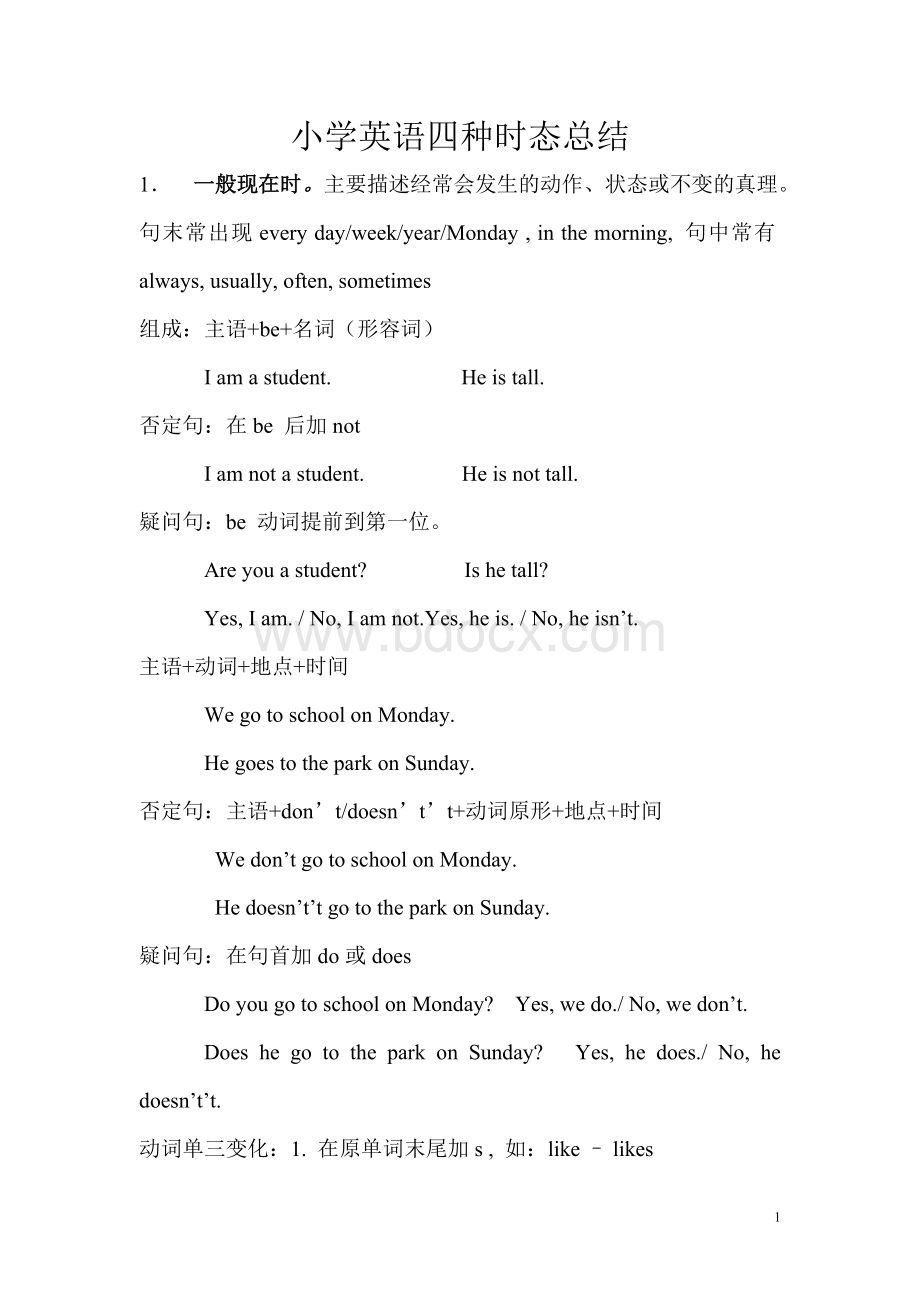小学英语四种时态总结Word文件下载.doc
《小学英语四种时态总结Word文件下载.doc》由会员分享,可在线阅读,更多相关《小学英语四种时态总结Word文件下载.doc(5页珍藏版)》请在冰豆网上搜索。

Areyouastudent?
Ishetall?
Yes,Iam./No,Iamnot.Yes,heis./No,heisn’t.
主语+动词+地点+时间
WegotoschoolonMonday.
HegoestotheparkonSunday.
主语+don’t/doesn’t’t+动词原形+地点+时间
Wedon’tgotoschoolonMonday.
Hedoesn’t’tgototheparkonSunday.
在句首加do或does
DoyougotoschoolonMonday?
Yes,wedo./No,wedon’t.
DoeshegototheparkonSunday?
Yes,hedoes./No,hedoesn’t’t.
动词单三变化:
1.在原单词末尾加s,如:
like–likes
2.单词以o,sh,ch,s,x结尾加es,如:
go–goes
3.单词末尾为辅音+y结尾去y加ies如:
study-studies
2.现在进行时:
主要叙述正在发生的事情。
句末常出现now,句首常出现look,listen
主语+be+动词ing形式
IamreadingEnglish.
Theyareswimming.
Heisplayingfootball.
在be后加not
IamnotreadingEnglish.
Theyarenotswimming.
Heisnotplayingfootball.
将be放到第一位。
AreyoureadingEnglish?
Yes,Iam./No,Iamnot.
Aretheyswimming?
Yes,theyare./No,theyaren’t.
Isheplayingfootball?
Yes,heis./No,heisn’t.
动词变ing形式:
1.在动词末尾加ing.如:
play-playing
2.末尾有e要去e加ing.如:
ride–riding
3.末尾以辅音元音辅音结尾双写末尾一个辅音如:
swim-swimming
3.一般将来时。
主要描述将来要发生的事情。
句末常出现nextMonday/week/year,tomorrow
主语+begoingto+动词原形
IamgoingtovisitAnn.
Theyaregoingtodrawadog.
Sheisgoingtorideahorse.
IamnotgoingtovisitAnn.
Theyarenotgoingtodrawadog.
将be提前
AreyougoingtovisitAnn?
Yes,Iam./No,Iamnot.
Aretheygoingtodrawadog?
Yes,theyare./No,theyaren’t.
Isshegoingtorideahorse?
Yes,sheis./No,sheisn’t.
主语+will+动词原形
Iwillgotothelibrary.
Theywillcleanthehouse.
Shewilleatbreakfastathome.
在will后加not或将willnot写为won’t
Iwillnotgotothelibrary.
Theywillnotcleanthehouse.
Shewillmoteatbreakfastathome.
将will提前
Willyougotothelibrary?
Yes,Iwill./No,Iwon’t.
Willtheycleanthehouse?
Yes,theywill./No,theywon’t.
Willsheeatbreakfastathome?
Yes,shewill./No,shewon’t.
4.一般过去时:
主要描述过去发生的事情.句末常出现lastnight/week/Monday/year,yesterday,ago
主语+动词过去式
Iwasapilot.
Theywerebusy.
Hewenttothemarket.否定句:
在普通动词前加didn’t动词恢复原形。
Iwasnotapilot.
Theywerenotbusy.
Hedidn’tgotothemarket.
提前be动词或在句前加did
Wereyouapilot?
Yes,Iwas./No,Iwasn’t.
Weretheybusy?
Yes,theywere./No,theyweren’t.
Didtheygotothemarket?
Yes,theydid./No,theydidn’t.
动词变过去式:
1.在原次末尾加ed或d如:
play-playedlike-liked
2.辅音加y结尾去y加ied如:
study-studied
3.辅音元音辅音结尾双写最后一个字母加ed如:
stop-stopped
特殊变化:
can-coulddo-dideat-atego-wenthit-hitpit-putsit-satcome-cameget-gothave-hadsee-sawbegin-begangive-gavewin-wonread-readam/is-wasare-wererun-ranhear-heardhide-hidlay-laidcut-cutwake-wokefall-fell
连系动词be是am,is,are三者的原形,一般不直接出现在句子中,而是以am,is,are的形式出现。
它们各有分工,而且随着主语的人称和数的变化而变化。
am最专一,始终跟着I转;
are跟you,we及表复数名词或复数意义的词连用;
is的交际最广泛,is与“他、她、它”形影不离,至于名词单数,指示代词(this/that)都与is结下不解之缘。
5